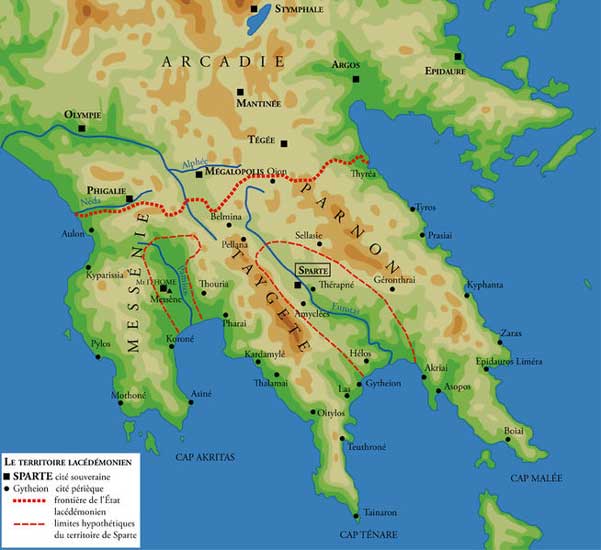|
|
The battle of Gythium took place in Gytheio (Gythium) in Mani, Greece. The Achaean League under Philopoemen and with the help of their Roman allies fought against the Spartans. The Spartans were defeated but Gytheio managed to hold out. The Battle of Gythium was fought in 195 BC between Sparta and the coalition of Rome, Rhodes, the Achaean League and Pergamum. As the port of Gytheio was an important Spartan base the allies decided to capture it before they advanced inland to Sparta. The Romans and the Acheans were joined outside the city by the Pergamese and Rhodian fleets. The Spartans held out but one of the joint commanders, Dexagoridas, decided to surrender the city to the Roman legate. When Gorgopas, the other commander, found out he killed Dexagoridas and took solo command of the city. After Dexagoridas' murder the Spartans held out more vigorously. However Flaminius arrived with 4,000 more men and the Spartans decided to surrender the city on the condition that the garrison could leave unharmed. The result of this battle forced Nabis, the tyrant of Sparta, to abandon the surounding land and withdraw to the city of Sparta. Later that year Sparta capitulated to the allies. The Macedonians had been defeated in the Second Macedonian War in 197 BC which left the Spartans in control of Argos. This Spartan gain was a setback for the Achean League who had been trying to incorporate Sparta into their league for many years. The Romans had won the Second Macedonian War and it left them in control of Greek affairs. However they decided not to occupy Greece but to garrison some cities for five years.[1] The tyrant of Sparta, Nabis, who had declared himself king, was troubling the Achean League and was also threatening to destroy the peace in Greece. In 195, Flaminius summoned his army in Greece and that of his allies at Plataea in Boeotia. He then marched from Plataea to Argos where he was joined by 10,000 Achean infantry and 1,000 cavalry.[2] After a few brief skirmishes the allies decided to abandon the siege and they pitched in Tegea.[3] They then advanced upon Caryae where they were joined by 1,500 Macedonians and 400 Thessalian cavalry. [4] Nabis also made his own preparations. Nabis had always ben on good terms with Cretan leaders and he requested 1,000 of their best soldiers who were hand picked to assist him. As well as the Cretans he hired 3,000 mercenaries and 10,000 citizens.[5] The Romans and their allies then advanced upon Sellasia not far north of Sparta. The Romans were defeated in a small battle and they retreated.[6] The Romans then won another battle against the Spartans and forced them to retreat into the city.[7]
Territory of Sparta in the classical age. Data from Kaplan (dir.), Le monde grec, Paris, 1995, p. 93. (Source) Battle Some coastal cities surrendered to the Romans which allowed the Romans to have a base in the coastal regions of Laconia.[8] Gythium was a large city and the Spartans naval base. The Romans advanced upon the city and they were joined there by the combined Rhodian and Pergamese fleets. The sailors from the Roman, Pergamese and Rhodian fleets built siege engines.[9] The Roman siege engines had devastating effects on the walls.[10] One of the city's joint commanders, Dexagoridas, offered to surrender the city to the Roman legate in charge of the fleet while Flamninius was gone.[11] When the other commander Gorgopas found out he murdered Dexagoridas.[12] Now with the city under Gorgopas' command the defenders became reinvigorated. The siege was proving more difficult until Flaminius arrived with 4,000 Roman soldiers.[13] With the arrival of the new soldiers, the allied soldiers were encouraged and began bombarding the city again with their siege engines while the Rhodian and Pergamese fleet continued to put pressure on the Spartans from the sea. The Spartans knew that they did not have much of a chance of withstanding the renewed allied assault and Gorgopas decided to surrender the city to the Romans under the condition that the garrison was allowed to leave the city unharmed.[14] Aftermath When Nabis found out that Gythium had fallen to the allies he decided to abandon the remaining Laconian countryside that he controlled. Nabis sent envoys to Flaminius who offered Nabis a parley.[15] The Romans attacked Sparta when the parley ended but the Spartans withstood the initial allied assualts. Nabis, however, seeing that the situation was hopeless agreed to surrender the city to the Romans.[16] The Romans forced Nabis to abandon Argos and most of the coastal cities of Laconia.[17] The Romans formed all the city that had broken off from Sparta on the Laconian coast into the Union of Free Laconians.[18] However, the Romans didn't strip Nabis of his powers because they wanted a state in the Peloponnese to counter the growing Achean League.[19] Nabis attack Gythium two or three later only to retreat after being unable to capture the city but in 192 he was assassainated by the Aetolians before he had a chance to attempt another attack on the city.[20] In 189, the Spartans having been deprived of a port attacked and captured the city of Las. The Acheans see this as there excuse to finish Sparta once and for all demanded the surrender of those responsible for the attack and when that was refused he captured the city.[21][22] Notes
References Primary Sources
Secondary Sources
Retrieved from "http://en.wikipedia.org/"
 |
|||||||||||||||

